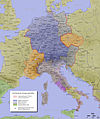Portal:Holy Roman Empire
- Overview
- Territories
- Featured Articles
- Good Articles
- Categories & lists
- Nobility project
- Holy Roman Empire task force
|
Welcome The purpose of the Holy Roman Empire portal is to make it easy for readers to find and explore articles about the Holy Roman Empire and its aristocratic families, as well as enabling editors to come together to work to enhance the subject and its themes. New editors are warmly welcome and invited to participate in adding new articles and improving existing ones – the first steps are very easy. Article of the month Article of the month
Imperial Reform  The Imperial Reform was an attempt, repeated in the fifteenth and sixteenth centuries, to adapt the structure and the constitution of the Holy Roman Empire to the requirements of the early German nation, and to give it a unified government, both under princely and imperial leadership. Unlike the kings of France or England, the Roman-German emperors since the High Middle Ages had not succeeded in consolidating the most important rights of state sovereignty in their hands. On the contrary, over the course of time the right of taxation, the jurisdiction of the Empire, the right to mint coinage, the right to build fortifications, and many other regalia passed down to the imperial princes and the free imperial cities. The gradual formation of the early German state was thus not taking place at imperial level, but at the level of the territorial princes.More...
Quick start Important noble families Important imperial treaties, edicts and legal sources Conflicts and key events Terminology Organisation of the Empire Structures
Institutions of the Empire
|
Holy Roman Empire On 25 December 800, Pope Leo III crowned the Frankish king Charlemagne Roman emperor, reviving the title more than three centuries after the fall of the Western Roman Empire in 476. The title lapsed in 924, but was revived in 962 when Otto I was crowned emperor by Pope John XII, as Charlemagne's and the Carolingian Empire's successor. From 962 until the 12th century, the empire was one of the most powerful monarchies in Europe. It depended on cooperation between emperor and vassals; this was disturbed during the Salian period. The empire reached the apex of territorial expansion and power under the House of Hohenstaufen in the mid-13th century, but overextension led to a partial collapse. The imperial office was traditionally elective by the mostly German prince-electors. In theory and diplomacy, the emperors were considered the first among equals of all of Europe's Catholic monarchs. A process of Imperial Reform in the late 15th and early 16th centuries transformed the empire, creating a set of institutions which endured until its final demise in the 19th century. On 6 August 1806, Emperor Francis II abdicated and formally dissolved the empire following the creation by French emperor Napoleon of the Confederation of the Rhine from German client states loyal to France. (Full article...) History of the Holy Roman Empire  The Holy Roman Empire (Latin Sacrum Romanum Imperium) was the official name for the sovereign territory of the Roman-German Emperor from the Middle Ages to the year 1806. The name of the Empire is derived from the claim of its medieval rulers that it continued the tradition of the Ancient Roman Empire. The Holy Roman Empire is the forerunner of the modern nation-states of Germany and Austria. To distinguish it from the German Empire founded in 1871 it is also referred to by modern historians as the “Old Empire” (German: Altes Reich) more... Well known people of the Holy Roman Empire Emperors and kings Important church leaders Members • 01.02 Portal:Holy Roman Empire • • Archive Wanted articles |
Associated Wikimedia
![]() Photos
Photos ![]() Source texts
Source texts ![]() Citations
Citations ![]() Dictionary
Dictionary














